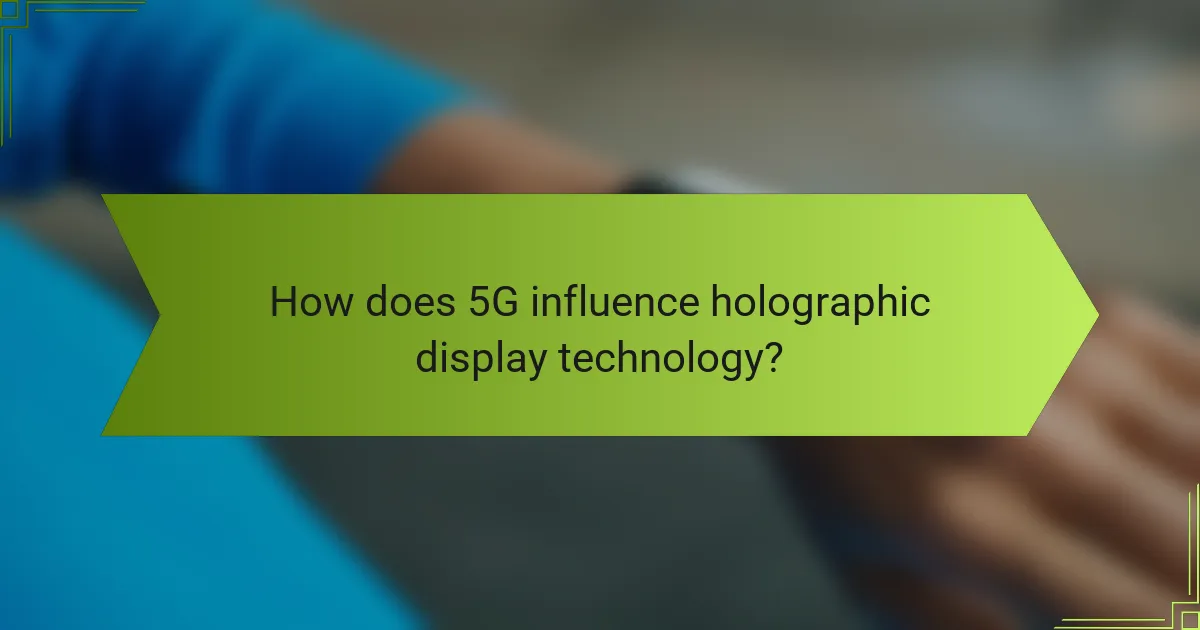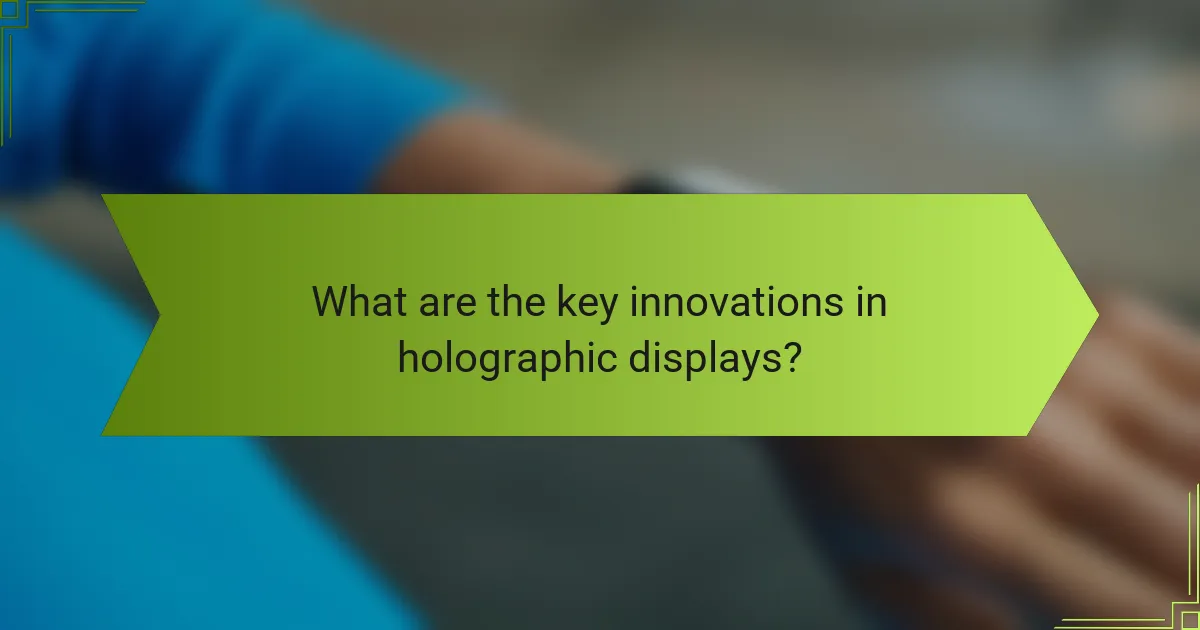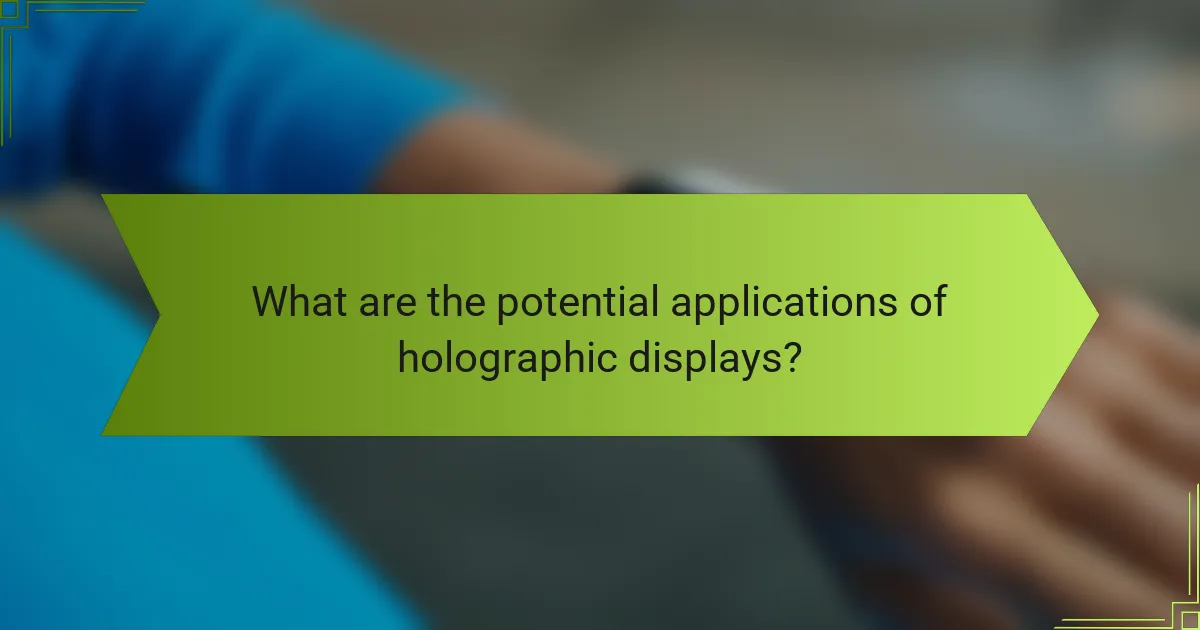Holographic display technology is poised for a revolution, driven by the capabilities of 5G networks that offer the speed and reliability necessary for immersive experiences. Innovations such as light field technology and augmented reality integration are making these displays more accessible and practical, while their potential to transform urban environments promises enhanced interactivity and visual communication in everyday life.

How does 5G influence holographic display technology?
5G significantly enhances holographic display technology by providing the necessary speed, capacity, and reliability for advanced applications. This next-generation network supports the high data rates and low latency required for immersive, interactive holographic experiences.
Increased bandwidth for real-time rendering
The increased bandwidth offered by 5G allows for real-time rendering of complex holographic images, which is essential for applications like virtual reality and augmented reality. With speeds potentially exceeding 1 Gbps, users can experience high-resolution holograms without lag or buffering.
This bandwidth enables the transmission of large data files quickly, making it feasible to stream detailed 3D content directly to devices. For instance, a holographic conference could display multiple participants in real-time, enhancing collaboration and engagement.
Lower latency for interactive experiences
5G’s low latency, often in the range of 1 to 10 milliseconds, is crucial for interactive holographic displays. This quick response time ensures that user inputs are processed almost instantly, creating a seamless experience that feels natural and immersive.
For example, in gaming, players can interact with holographic elements without noticeable delay, making the experience more engaging. This responsiveness is vital for applications in training simulations or remote assistance, where real-time feedback is essential.
Enhanced connectivity for multiple users
5G enhances connectivity, allowing multiple users to interact with holographic displays simultaneously. This capability is particularly beneficial in collaborative environments, such as design studios or educational settings, where several participants can view and manipulate the same holographic content.
With the ability to support a high number of connections, 5G networks can facilitate group activities without compromising performance. This means that in a shared holographic space, users can engage with the content and each other in real-time, fostering a more interactive and dynamic experience.

What are the key innovations in holographic displays?
Key innovations in holographic displays include advancements in light field technology, integration with augmented reality, and the development of portable devices. These innovations enhance the visual experience, making holographic displays more accessible and practical for various applications.
Light field technology advancements
Light field technology has significantly evolved, allowing for more realistic and immersive holographic images. This technology captures and reproduces light from multiple angles, creating a three-dimensional effect that can be viewed without special glasses. Recent developments have improved resolution and depth perception, making holograms more lifelike.
One notable advancement is the use of micro-lens arrays, which help to project high-quality images while reducing the size of the display. This makes it feasible to create larger holographic displays that maintain clarity and detail, suitable for both commercial and personal use.
Integration with augmented reality
The integration of holographic displays with augmented reality (AR) enhances user interaction and engagement. By overlaying digital information onto the real world, users can experience a seamless blend of virtual and physical environments. This integration is particularly beneficial in fields like education, training, and entertainment.
For instance, in medical training, holographic displays can project 3D models of anatomy, allowing students to interact with the material in a more meaningful way. This practical application demonstrates how AR and holographic technology can work together to improve learning outcomes.
Development of portable holographic devices
Portable holographic devices are becoming increasingly popular, driven by advancements in miniaturization and battery technology. These devices enable users to access holographic content on-the-go, making them suitable for various applications, from gaming to business presentations. The convenience of portability opens up new possibilities for user engagement.
Examples of portable holographic devices include handheld projectors and smart glasses that can display holograms in real-time. As these technologies continue to develop, we can expect more versatile and user-friendly options to emerge in the market, catering to both consumers and professionals alike.

What are the expectations for holographic displays in urban environments?
Holographic displays are anticipated to transform urban environments by enhancing interactivity and visual communication. These displays will leverage advancements in 5G technology to provide real-time, immersive experiences that can be integrated into various aspects of city life.
Smart city applications
In smart cities, holographic displays can facilitate improved traffic management, public safety, and energy efficiency. For instance, real-time holographic maps can guide drivers and pedestrians, while emergency services can use them for situational awareness during crises. The integration of these displays with IoT devices can streamline urban operations.
Moreover, holographic displays can serve as interactive kiosks, providing residents and visitors with information about local services, events, and navigation. This can enhance the overall user experience in urban settings.
Advertising and marketing enhancements
Holographic displays offer innovative advertising opportunities by creating eye-catching, three-dimensional visuals that capture consumer attention. Brands can utilize these displays in high-traffic areas to showcase products in a more engaging manner, potentially increasing foot traffic and sales.
Additionally, the ability to personalize holographic advertisements based on viewer demographics or behavior can lead to more effective marketing strategies. This targeted approach can significantly improve return on investment for advertisers.
Public information displays
Public information displays using holographic technology can enhance communication between city authorities and residents. These displays can convey important messages about public health, safety alerts, or community events in a visually compelling way that is easy to understand.
For example, during emergencies, holographic displays can provide real-time updates and instructions, ensuring that the public receives critical information quickly. This capability can be vital in maintaining public safety and awareness in urban environments.

What are the challenges facing holographic display technology?
Holographic display technology faces several significant challenges that hinder its widespread adoption. Key issues include high production costs, complexities in content creation, and hurdles in market acceptance.
High production costs
The production of holographic displays involves advanced materials and intricate manufacturing processes, leading to high costs. These expenses can range from thousands to tens of thousands of dollars per unit, making it difficult for companies to justify large-scale production.
To mitigate costs, manufacturers are exploring alternative materials and more efficient production techniques. Innovations such as 3D printing and improved light modulation technologies may help reduce expenses over time.
Content creation complexities
Creating content for holographic displays is more complex than traditional media. It requires specialized software and skills to produce 3D models and animations that can be effectively rendered in a holographic format.
Additionally, the need for high-resolution graphics and real-time rendering capabilities adds to the complexity. Content creators must invest in training and tools, which can be a barrier for many potential developers.
Market adoption hurdles
Market adoption of holographic displays is slow due to a lack of consumer awareness and understanding of the technology. Many potential users are unfamiliar with the benefits and applications of holographic displays, which can impede interest and investment.
Furthermore, existing infrastructure may not support the integration of holographic technology, requiring additional investment in hardware and software. Companies looking to adopt this technology should consider pilot programs to demonstrate its value and educate potential users.

How to choose the right holographic display for your needs?
Choosing the right holographic display involves assessing your specific requirements, including resolution, compatibility with existing technology, and user experience. Understanding these factors will help you make an informed decision that meets your needs effectively.
Assessing resolution and clarity
Resolution and clarity are critical when selecting a holographic display. Higher resolutions, typically measured in pixels per inch (PPI), provide sharper images and more detailed visuals. Look for displays that offer at least 1080p resolution for basic applications, while 4K or higher is preferable for professional use.
Additionally, consider the clarity of the display under various lighting conditions. Some holographic displays may perform better in bright environments, while others may require controlled lighting for optimal viewing. Always check user reviews and specifications to gauge performance in real-world scenarios.
Evaluating compatibility with existing technology
Compatibility with your current technology is essential to ensure seamless integration. Check if the holographic display supports the same connectivity options as your devices, such as HDMI, USB-C, or wireless protocols. This can prevent additional costs for adapters or new hardware.
Furthermore, consider software compatibility. Ensure that the display can work with the applications and platforms you intend to use. Some holographic displays may come with proprietary software, which could limit your options for customization or integration with existing systems.
Understanding user experience requirements
User experience is a vital aspect of choosing a holographic display. Think about how the display will be used, whether for presentations, entertainment, or interactive applications. This will influence the size and type of display you need.
Gather feedback from potential users to understand their preferences and requirements. For instance, if the display will be used in a collaborative environment, consider models that support multi-user interactions. Prioritize displays that offer intuitive interfaces and easy navigation to enhance overall user satisfaction.

What are the potential applications of holographic displays?
Holographic displays have a wide range of potential applications across various fields, enhancing user experience and interaction. Their ability to present three-dimensional images can transform industries such as healthcare, education, and entertainment.
Healthcare and medical training
In healthcare, holographic displays can revolutionize medical training and patient care. Medical professionals can visualize complex anatomical structures in 3D, allowing for better understanding and preparation for surgeries. For instance, a holographic model of a heart can help surgeons practice before performing a procedure, reducing risks and improving outcomes.
Additionally, holographic displays can facilitate remote consultations, enabling doctors to interact with patients in a more immersive way. This technology can enhance telemedicine by providing a realistic view of patient conditions, leading to more accurate diagnoses and treatment plans.
Education and remote learning
In the realm of education, holographic displays can create engaging learning environments that enhance student comprehension. By visualizing complex concepts, such as chemical reactions or historical events, students can gain a deeper understanding of the material. For example, a holographic representation of the solar system allows learners to explore planetary movements interactively.
Remote learning can also benefit from this technology, as it bridges the gap between physical presence and virtual classrooms. Educators can use holographic displays to present lessons in a captivating manner, making it easier for students to stay focused and retain information. This approach can be particularly effective in subjects that require spatial understanding, such as geometry or biology.
